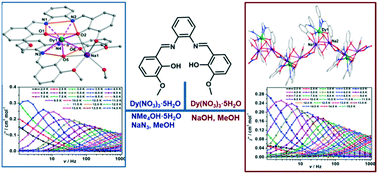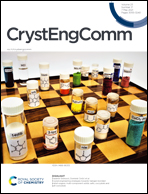Regulating the distortion degree of the square antiprism coordination geometry in Dy–Na single ion magnets†
Abstract
A novel [DyIIINaI] complex, [DyNa(L)2(MeOH)]·MeOH (1, H2L = N,N′-bis(2-oxy-3-methoxybenzylidene)-1,2-phenylenediamine), and a zigzag 1D chain based on the [DyIIINaI2] subunit, [DyNa2(L)2(NO3)]n·MeOH (2), were obtained by employing a multidentate Schiff base ligand H2L reacting with Dy(NO3)3·5H2O, NaN3 and NMe4OH·5H2O in MeOH or reacting with Dy(NO3)3·5H2O and NaOH in methanol. Structural analyses revealed that the DyIII in 1 and 2 is sandwiched between two L2− ligands, namely, the DyIII ion was coordinated by four phenoxido O and four amine N atoms from two L2− ligands. SHAPE software calculations and structural analysis indicated that the coordination geometry of DyIII in 1 and 2 is a distorted square antiprism (D4d), but the distortion degree of DyIII in 1 was smaller than that in 2. Additionally, in 1, one NaI is located on one of the N2O2 planes, and the NaI is coordinated by three phenoxido O and three methoxy O atoms from two L2− ligands and one coordinated MeOH molecule. However, in 2, two NaI ions are located on each of the N2O2 planes, in which the coordination environment of each NaI is completed by three phenoxido O atoms, three methoxy O atoms and two O atoms from one NO3− ion. Moreover, the [DyIIINaI2] units are linked into a zigzag 1D chain by nitrate anions. ac magnetic susceptibility measurements revealed that both complexes 1 and 2 exhibit field-induced single ion magnet behavior under a 1000 Oe dc field, with values of the effective energy barrier (Ueff) of 65.33(1) K for 1 and 84.23(1) K for 2. Interestingly, the Ueff values of 1 and 2 are both higher than the corresponding value of 40.1 K for a reported complex with the coordination geometry of a bicapped triangular prism. The moderate SIM performance of 1 and 2 in the Dy(III)-based SIMs with a SAP coordination geometry could be ascribed to the compressed SAP coordination environment of DyIII ions, dipole–dipole interactions and the deviation of the anisotropic axes from the S8 axis.

- This article is part of the themed collection: Database Analysis


 Please wait while we load your content...
Please wait while we load your content...